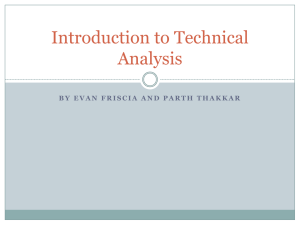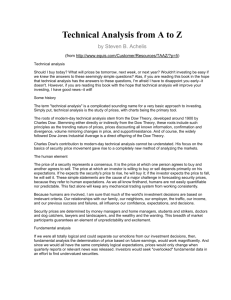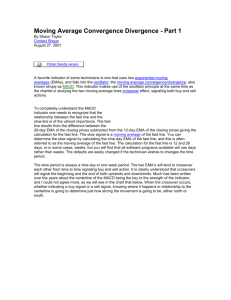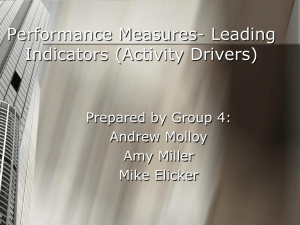Technical Analysis
advertisement
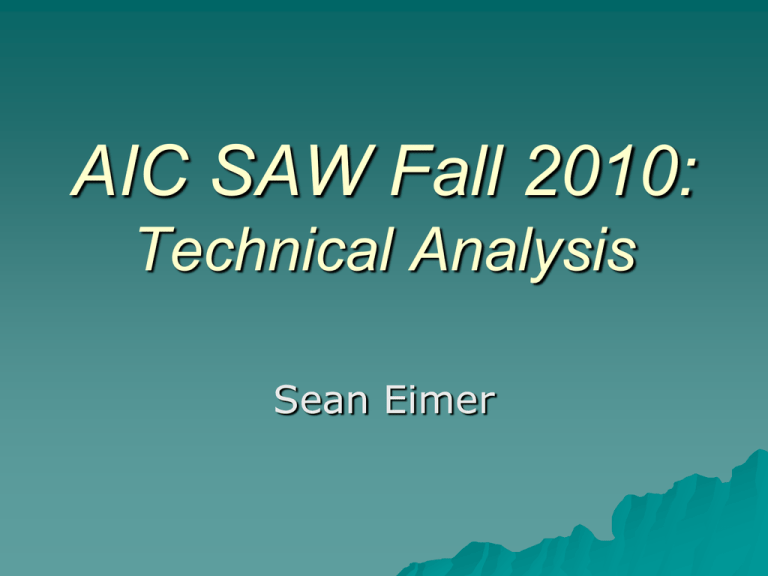
AIC SAW Fall 2010: Technical Analysis Sean Eimer Diaries of a Trader 1)Apple (Aapl) 2)SanDisk (SNDK) Apple Quote: Originally Posted by Fibman2005 on 8/24 I'm actually going bullish here. I agree, if it does break below that level with conviction I can see it going to 230. I bought a position at 241 looking for a bounce. Full STO is oversold and Apple is sitting on support right now with selling volume declining. I think Apple will sit on support until the market finds support. If Apple does break below 239 (my stop) I'll buy more at the 230 level. Apple is range bound right now and my target is set around 265-270. My analysis is based of TA, but from a fundamental perspective I like Apple at 14.8x forward earnings anyways. To be clear, I have two portfolios and I have a long position on Apple I don't trade in one, and in the other I'm making a trade on Apple. Posted on 8/31 I think the market is about to find support and I think Apple can easily hit my target once the market starts to take off. Apple has been holding pretty well right at support ahead of tomorrows event. I sold my margin on Apple at 244.20 today in after-hours and will hold my original position through the event. I'm looking to add more at a pullback if we take off tomorrow or add more if we break through support tomorrow. Keep in mind the 200 day moving average is at 231ish right now. GLTA! Current Stock Chart (Apple) 23.88% Since August 24th SanDisk Quote: Originally Posted by Fibman2005 I actually like SNDK as a short here. The stock has been in a healthy uptrend from 2009 to mid 2010 then traded sideways. The stock recently broke through support and is now testing the 38 level. SNDK posted a doji on the daily w/ the high being 37.54 on Friday. Until I get a better picture of trends in the NAND chip market, this is going to be a trade instead of an investmet. Demand still seems to be strong for NAND chips, but I fear oversaturation which would lead to a decline in ASP for NAND chips, a key revenue driver for Sandisk. I'm going to short on Monday anywhere around 36 - 38 w/ a stop around 38.50. In my experience, a doji at resistance is usually bearish. Notice, the volume on the break of support and the decrease of buying volume as the stock went from 32 to 37. SanDisk Enlarged SanDisk Enlarged What is Technical Analysis Technical analysis is a method of evaluating securities by analyzing the statistics generated by market activity, such as past prices and volume. Technical analysts do not attempt to measure a security's intrinsic value, but instead use charts and other tools to identify patterns that can suggest future activity. Basic Assumptions: 1) Market discounts everything 2) Price moves in trends 3) History tends to repeat itself The Bottom Line: Technical Analysis helps define price objectives, define risk, and take emotion out of the trade Technical analysts examine what investors fear or think about fundamental developments Technical Analysis combines the concept of psychology and supply/demand. Price action also tends to repeat itself because investors collectively tend toward patterned behavior – hence technicians' focus on identifiable trends and conditions. Static vs. Dynamic Herd Mentality Zero-Sum Game Market Discounts Everything A major criticism of technical analysis is that it only considers price movement, ignoring the fundamental factors of the company. However, technical analysis assumes that, at any given time, a stock's price reflects everything that has or could affect the company - including fundamental factors. Technical analysts believe that the company's fundamentals, along with broader economic factors and market psychology, are all priced into the stock, removing the need to actually consider these factors separately. This only leaves the analysis of price movement, which technical theory views as a product of the supply and demand for a particular stock in the market. Identifying the Trend: “The trend is your friend” What is a Trendline? What Does a Trendline Mean? A line that is drawn over pivot highs or under pivot lows to show the prevailing direction of price. Trendlines are a visual representation of support and resistance in any time frame. Two types of trends: 1) Uptrend 2) Downtrend Three Types of Markets: 1) Up 2) Down 3) Sideways Moving Averages: Moving averages can be used to identify the direction of the trend or define potential support and resistance levels Types of Moving Averages: – – – – – – Simple Moving Average Exponential Moving Average Time Series Volume Weighted Moving Average (VWAP) Triangular Moving Average Variable Moving Average How to use moving averages is more important than the definitions. Most people don’t know how to use moving averages properly Simple Moving Average A simple moving average is formed by computing the average price of a security over a specific number of periods. Most moving averages are based on closing prices. As its name implies, a moving average is an average that moves. Popular time frames: – – – – – 10 day 20 day 50 day 100 day 200 day Exponential Moving Average Exponential moving averages reduce the lag by applying more weight to recent prices. The weighting applied to the most recent price depends on the number of periods in the moving average. Popular time frames: – – – – – – 5 day 10 day 20 day 30 day 50 day 100 day Which ema should you use and when? Moving Average Crossovers Used to identify changes in the trend Most widely known is the golden cross where the 50 day moving average crosses above the 100 day moving average Ichimoku Clouds The Ichimoku Cloud is a versatile indicator that defines support and resistance, identifies trend direction, gauges momentum and provides trading signals. With one look, chartists can identify the trend and look for potential signals within that trend. Trading Using the Cloud We’ll go in more detail in later SAW presentations Support & Resistance We’ve mentioned moving averages and trendlines can act as support or resistance, but what does that really mean? Is Support and Resistance analogous to Supply and Demand? Is the market really just one large auction made up of buyers and sellers? Support & Resistance Support and resistance represent key junctures where the forces of supply and demand meet. Prices are driven by excessive supply (down) and demand (up) Supply = bearish, bears and selling Demand = bullish, bulls and buying As demand increases, prices advance As supply increases, prices decline When supply and demand are equal, prices move sideways as bulls and bears fight for control Support: The price level at which demand is thought to be strong enough to prevent the price from declining further. The logic dictates that as the price declines towards support and gets cheaper, buyers become more inclined to buy and sellers become less inclined to sell. Resistance: The price level at which selling is thought to be strong enough to prevent the price from rising further The logic dictates that as the price advances towards resistance, sellers become more inclined to sell and buyers become less inclined to buy. Note: Technical analysis is not an exact science and it is sometimes difficult to set exact support & resistance levels. In addition, price movements can be volatile and dip below support & resistance briefly. Sometimes it does not seem logical to consider a support level broken if the price closes 1/8 below the established support level. For this reason, some traders and investors establish support zones. Also, its often common for resistance to become support or support to become resistance when a stock rises or falls Possibly (not exact) = Dynamic??? So where does volume come into the equation and can it be used as a confirmation since we established the market is just one big auction? How do you define a support or resistance zone and how do you interpret that? What does volume mean? Volume The number of shares or contracts traded in a security or an entire market during a given period of time. It is simply the amount of shares that trade hands from sellers to buyers as a measure of activity Used to measure the worth of a market move. If the markets have made strong price move either up or down the perceived strength of that move depends on the volume for that period Bottom Line: The higher the volume during that price move the more significant the move Volume as Confirmation: Support & Resistance Zones (by Volume) We’ll go over in more detail Volume by Price in later SAW presentations BUT Volume by Price is a great way to define support and resistance zones by showing the level of strength of the zone by the amount of market participants Volume by Price – Showing We’ll go over Gaps trading Gaps in more detail in later SAW presentations, but vol. by price help identify gaps. Basically, gaps act as resistance or support and usually get filled. There are some very profitable trading tactics to profit from gaps we’ll discuss in future SAWs Volume by Price Examples The chart shows a long Volume by Price bar marking support around 42-44 in mid August. Also notice that the stock forged at least three reaction lows around 42 from early July to mid August. This support (demand) zone is clearly marked. Volume by Price Examples The chart shows SNDK breaking below the previously identified Volume by Price support zone with high volume. Demand crumbled, supply won the day and prices moved sharply lower. Market Indicators This is where it gets fun I have counted over 100 different types of market indicators on Think or Swim platform and that number will continue to grow as traders come up with new indicators Popular indicators: – – – – – – – – – – – – Average True Range (ATR) Commodity Channel Index (CCI) Chaikin Money Flow (CMF) Detrended Price Oscillator (DPO) Moving Average Convergence-Divergence (MACD) Money Flow Index (MFI) On Balance Volume (OBV) Percentage Price Oscillator (PPO) TRIX Ultimate Oscillator Williams %R Relative Strength Index Is the Market Trending or Oscillating? How the market is acting will determine which indicators we should use You SHOULD NEVER USE oscillating indicators when the market is trending or vice versa…NEVER! Oscillating: Moving up and down with no apparent trend Popular Oscillating Indicators: 1) Full Stochastics 2) Williams %R 3) Force Index We’ll discuss more in greater detail in future SAWs. For now we’ll focus on the most important one…Full Stochastics Stochastic Calculus? Stochastic calculus is a branch of mathematics that operates on stochastic processes. It allows a consistent theory of integration to be defined for integrals of stochastic processes with respect to stochastic processes. It is used to model systems that behave randomly Stochastic Calculus and how it relates to interpreting cycles and stock patterns in the market is what I’m currently doing my research on. Part of my thesis relates to taking static indicators and making them dynamic. I’ve taken this concept and have been creating my own indicator that can show whether the market is trending or oscillating and how to trade that cycle. Some interesting phenomenon occurs when you use stochastic calculus on a summation index, price ratios, etc. Basically anything put price. •For our purposes though, we’ll just start off with using the Full Stochastic Indicator Full Stochastic How do you know what time frame to use? How do you know what parameters to use? Is it easier to short or go long using Stochastics? Notice how combining Full Stochastics and support/resistance make for profitable trades Is the Market Trending or Oscillating? How the market is acting will determine which indicators we should use You SHOULD NEVER USE oscillating indicators when the market is trending or vice versa…NEVER! Trending: Rising prices or declining prices over indicated time period Popular Trending Indicators: 1) MACD 2) RSI 3) ROC We’ll discuss more in greater detail in future SAWs. For now we’ll focus on the most important ones…RSI & MACD Relative Strength Index (RSI) The Relative Strength Index (RSI) is a momentum oscillator that measures the speed and change of price movements Traditionally, and according to Wilder, RSI is considered overbought when above 70 and oversold when below 30 Signals can also be generated by looking for divergences, failure swings and centerline crossovers. RSI can also be used to identify the general trend Using RSI RSI tends to fluctuate between 40 and 90 in a bull market (uptrend) with the 40-50 zones acting as support. These ranges may vary depending on RSI parameters, strength of trend and volatility of the underlying security. Exact opposite occurs for bear markets Bear Markets Divergences You want RSI to be increasing with the upward trend or decreasing when the stock is downward trend. This is convergence and anything else is divergence Notice: Stock fell after bearish divergence and stock rose after bullish divergence Does this mean a new trend or just a reallocation of supply or demand? Moving Average Convergence Divergence (MACD) Moving Average Convergence-Divergence (MACD) is one of the simplest and most effective momentum indicators available MACD turns two trend-following indicators, moving averages, into a momentum oscillator by subtracting the longer moving average from the shorter moving average As a result, MACD offers the best of both worlds: trend following and momentum MACD fluctuates above and below the zero line as the moving averages converge, cross and diverge Traders can look for signal line crossovers, centerline crossovers and divergences to generate signals Because MACD is unbounded, it is not particularly useful for identifying overbought and oversold levels. Interpretation Positive MACD indicates that the 12-day EMA is above the 26-day EMA. Positive values increase as the shorter EMA diverges further from the longer EMA. This means upside momentum is increasing Negative MACD indicates that the 12-day EMA is below the 26-day EMA. Negative values increase as the shorter EMA diverges further below the longer EMA. This means downside momentum is increasing Signal Line Crossovers A bullish crossover occurs when MACD turns up and crosses above the signal line A bearish crossover occurs when MACD turns down and crosses below the signal line Crossovers can last a few days or a few weeks, it all depends on the strength of the move Divergences Similar to what we said for RSI Notice: Stock fell after bearish divergence and stock rose after bullish divergence Does this mean a new trend or just a reallocation of supply or demand? Putting it all Together! Quote: Originally Posted by Fibman2005 Some of the indicators I use analyze summation indexes and time. We're two-three standard deviations away from the mean suggesting the market is at an extreme level right now. Using Stochastic calculus, the differential suggests the market is in a rotating phase as the differential approaches zero. Combine this with the fact that the market is teetering at resistance (Psychological Resistance as well) @ 11,000 on the Dow suggests the market needs to cool off. Unfortunately, what needs to happen and what does happen are completely different, I just don't like the odds of the market being pushed that much higher in the short run. Market internals are starting to diverge and everyone thinks its a win-win scenario with the Fed initiating Quantitative Easing. On the bear side, I like how CNBC is bringing this win-win scenario and the "currency war" to everyone's attention. This is going to be an important week for equities with earnings coming out and I think a lot of good news is already baked into the market. Still waiting for the dollar to find support and rise. I'm only holding my SNDK short around the 40 level, but looking to get into some short-bias etfs. Unfortunately, probability is only a probability and shouldn't be taken as anything else. Also, there's no indication whether the market experiences an extreme sell off or just a minor correction. Though, important to note that the market volume is on the weak side and VIX is below 20. Something to Consider (Not to scare you off though) From a good friend and very experienced trader: Markets have gotten much more complex and far less predictable in the last 2-3 years. However, that does not mean that you cannot develop a system (either by using stocks or options), were you can take advantage of these erratic price swings. If there something that you must understand is the following; today's market operate in a different manner than they did before. That is, today's markets merely reflect actual valuations, instead, markets reflect (or trade on) expectations. Whether your right or wrong on your expectation, it doesn't really matter, as long as your able to correctly read the trend. This 'game' will obviously set the market to eventually fail (as most expectations will never be met), but in the meantime, you can take advantage of it and trade on it. I guess the point(s) I am trying to get across is this; 1)understand how to minimize risk and optimize profits, 2)understand that today's markets operate in a different manner, and as a result, you will have to adapt to it, and 3) trade based on expectations, not actual salutations (If markets were trading at actual valuations, as they were designed to do, we would be below DOW 9K, but hey, human are the most irrational being on the face of this planet). Its important to understand the indicators and definitions within technical analysis. But just like Fundamental Analysis, its interpretation is what separates the profitable traders from everyone else. How you should use certain indicators and the combination of such indicators will be discussed in future SAW presentations. Also, looking at efficiency ratios with respect to trends and going over certain trades will be discussed in full detail. The goal is to provide you with the tools of technical analysis and teach you to use them accurately to profit from inefficiencies in the market
